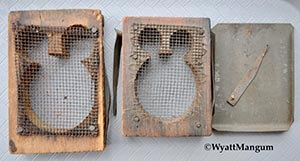
Requeening is an important component of bee management. Replacing old queens with young vigorous egg-layers helps keep colonies strong and productive. Queen replacement also gives the beekeeper control over the stock to maintain gentleness, disease and mite tolerance, reduced inclination to swarm, and high honey production.
The basic strategy of requeening is straightforward in principle. First find the old queen and remove her. Then introduce the new queen into the bees. At first the queen resides in a protective cage because the bees of the recipient colony typically regard her as a foreign queen and will try to kill her. In the usual scenario, their aggression subsides, and the colony accepts the new queen. Then by some mechanism (usually by removing candy blocking the cage’s exit hole), the bees release the queen, and she begins laying eggs. However even for a colony known to be queenless, getting the bees to accept a new queen is sometimes difficult and perplexing. The bees of the receiving colony may just kill the new queen, resulting in a disappointing and expensive loss, given the high cost of queens.
For example, I study queen introduction with 30 observation hives (single comb) maintained in a special bee house. Although the smaller colonies are thought to be more accepting of queens compared to large colonies, these observation colonies (with maybe a couple thousand bees) will sometimes kill the new queens for no obvious reason, retaining the behavior of large colonies. With the looming specter of queen bee death, beekeepers, ever inventive, have devised ways to introduce queens, both in the procedure of introducing her, and the style of cage used to protect her.
Given their disposable nature, old queen cages are quite rare. When found, their historical origins often remain obscure. Nevertheless, I have been able to resurrect the histories of some of these cryptic little cages. For instance, a beekeeper introducing a queen in the latter 1880s might have used a cage invented by Theodore O. Peet from Arlington, New Jersey (see Figure 1). The cage has screen on one side. A tin slide covers the other side. From the outer edges of the cage, two long tin points could be pushed into the brood comb. With the Peet cage anchored on the comb, the beekeeper slid out the tin, letting the queen have access to the comb. This arrangement made the Peet cage function somewhat like a modern push-in screen cage since the queen would be confined on the comb during the introduction period. And yes, the bees did chew the comb under the sides of the cage and enter it as noted by beekeepers (just as bees sometimes do when we use a screen push-in cage).
Years ago I remember seeing my first Peet cage in person –– not just a picture in an old beekeeping book. A farmer was showing me antique beekeeping equipment stored in an old shed since the 1880s. From dark dusty corners in the dimly-lit shed, he pulled out all kinds of old beekeeping gadgets. I could identify most of them right on the spot. Suddenly in the shadowy light coming through the dirty windowpanes, I saw that rare and elusive queen cage. Without hesitation, I chirped, “That’s a Peet cage for requeening.” The farmer eyed me in suspicious disbelief. Apparently the identity and use of this little cage had perplexed him for a long time. Now some plucky upstart waltzes into the old dilapidated shed and zaps the mystery out of the cage. After identifying about all the other old exotic beekeeping equipment in the shed and even in another shed, I finally wore him down, and he started believing me. (I ended up buying it all, five pickup truck loads, my largest acquisition. It was a virtually complete beekeeping operation stored there since the late 1800s, including hives, a homemade extractor, and a foundation mill, a stunning find.)
Another interesting introduction cage, made around the 1940s, is called the Ideal cage (see Figure 2). This cage is all metal with a wire attached to a pull ring. The cage goes between the frames and the beekeeper runs the wire out of the hive from between the hive bodies, leaving the pull ring exposed to the outside. After a few days, guessing by then the bees are ready to accept the queen, the beekeeper pulls the ring, which opens the cage and releases her. This method has the advantage of a controlled release without opening the hive and disturbing the bees (who might in turn kill the new queen due to the disturbance).
First, we saw a queen introduction cage made of wood (Peet). The second cage was made of metal (Ideal). Was a queen cage ever made of cardboard? Yes. Including a little clear cellophane window? Of course.
Figure 3 shows an Ashurst Sureway Queen Cage, unfolded in two pieces. Julian Ashurst of Westmoreland, California patented the cage on April 10, 1944 (patent number 2,403,840). Figure 4 shows the technical patent diagram of the little cardboard queen cage in all its ….


